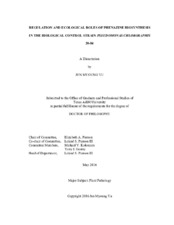| dc.description.abstract | Pseudomonas chlororaphis 30-84 is a plant growth-promoting rhizobacterium that was selected for its ability to control plant disease. Disease suppression by 30-84 is the result of production of phenazines, which both inhibit plant pathogens and facilitate rhizosphere competence. Many phenazine producing pseudomonads, such as 30-84, produce more than one phenazine derivative mediated by unique phenazine modification enzymes. To determine the role of different phenazine derivatives on key biocontrol properties, isogenic derivatives of 30-84 that produced different phenazines were constructed. The production of different phenazine derivatives significantly affected the specificity of fungal pathogen inhibition as well as biofilm eDNA release, which correlated with differences in biofilm formation.
Sequence analysis of the phenazine operon of 30-84 identified several DNA sequence features downstream of the phenazine operon promoter. These features potentially are capable of forming stem-loop structures, which lead to promoter attenuation. To analysis of unusual regulatory circuit in phz promoter, we generated mutants with a disruption of the stem-loop structures. Of significance, this disruption resulted in significantly higher phenazine production as well as increased expression of the phzR/phzI quorum-sensing system. These data suggest that this stem-loop region negatively regulates phenazine production, partially through phzR/phzI. In addition, this mutant had greater fungal inhibition capacity, biofilm formation and plant growth promotion, which are fundamental factors of biocontrol agents. Therefore, this work provides potential applications for improved biological control by an enhanced phenazine strain.
Regulatory genes and systems including Gac/Rsm, RpeA/RpeB, RpoS, Pip and PhzR/PhzI tightly control phenazine production in 30-84. In this study, we identified a Tn5 generated mutant that disrupted the gene miaA, which encodes a tRNA modification enzyme. This mutant showed significantly decreased production of phenazines, exoprotease and quorum sensing signals. Moreover, transcript abundances of phzR/phzI as well as pip, and translational efficiency of RpeB and RpoS were significantly reduced in the miaA mutant. In addition, the miaA mutant showed reduced bacterial growth, survival rate in the soil, and antifungal activity. These results suggest MiaA influences the production of secondary metabolites and other traits involved niche adaptation in P. chlororaphis 30-84 via its tight control of the translation of key regulatory genes. | en |


